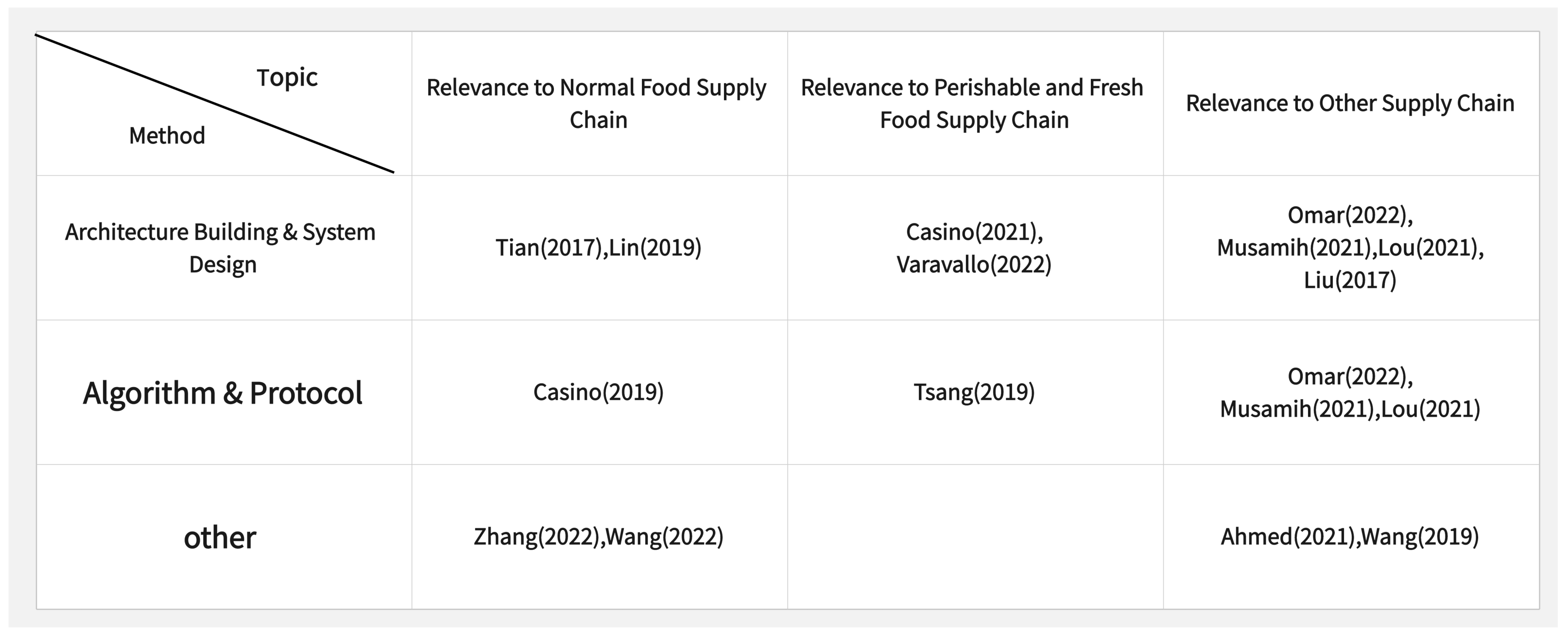A Literature Review of Blockchain-Based Applications in Supply Chain
Abstract
1. Introduction
2. Blockchain Overview
2.1. The Origin of Blockchain
2.2. The Structure of Blockchain
2.3. Key Features
2.3.1. Trust and Transparency
2.3.2. Immutability and Traceability
2.3.3. Privacy Security
2.4. Blockchain Type
2.4.1. Public Blockchain
2.4.2. Consortium Blockchain
2.4.3. Private Blockchain
3. Methodology
- First of all, to make the search for papers more comprehensive, ‘blockchain’ with ‘supply chain’ or ‘logistics’ are combined;
- Second, to make the search more relevant to the topic, a third keyword would be added for the application, that is, ‘model’, ‘scheme’, and ‘framework’. In addition, we would add the articles with the keyword ‘smart contract’;
- Finally, based on the previous three directions, the third keywords would be replaced with ‘traceability’, ‘transparency’, ‘data’, ‘access control’, and ‘information’.
- 1.
- ‘blockchain’ AND ‘supply chain’ OR ‘logistic’;
- 2.
- ‘blockchain’ AND ‘supply chain’ OR ‘logistic’ AND ‘model’;
- 3.
- ‘blockchain’ AND ‘supply chain’ OR ‘logistic’ AND ‘framework’;
- 4.
- ‘smart contract’ AND ‘supply chain’ OR ‘logistic’;
- 5.
- ‘blockchain’ AND ‘supply chain’ OR ‘logistic’ AND ‘traceability’;
- 6.
- ‘blockchain’ AND ‘supply chain’ OR ‘logistic’ AND ‘transparency’;
- 7.
- ‘blockchain’ AND ‘supply chain’ OR ‘logistic’ AND ‘access control’;
- 8.
- ‘blockchain’ AND ‘supply chain’ OR ‘logistic’ AND ‘information’.
- 1.
- The citation of a paper in 2016 should at least 100;
- 2.
- The citation of a paper in 2017 should at least 75;
- 3.
- The citation of a paper in 2018 should at least 50;
- 4.
- The citation of a paper in 2019 should at least 25;
- 5.
- The citation of a paper in 2020 should at least 25.
4. Blockchain Based Applications within Supply Chain
4.1. Traceability and Transparency
4.1.1. Relevance to Normal Food Supply Chain
4.1.2. Relevance to Perishable and Fresh Food Supply Chain
4.1.3. Relevance to Other Supply Chain
4.2. Trade Behavior
4.2.1. Efficiency Improvement
4.2.2. Storage Optimization
4.2.3. Cost Saving
4.2.4. Secure Trade
4.3. Data Security and Access Control
4.3.1. Security within IoT Devices
4.3.2. Security in Medical Field
4.3.3. Sub-Blockchain Network
4.3.4. Access Control
5. Discussion
5.1. Traceability and Transparency
5.2. Trade Behavior
5.3. Data Security and Access Control
6. Conclusions
Author Contributions
Funding
Institutional Review Board Statement
Informed Consent Statement
Data Availability Statement
Conflicts of Interest
References
- Nakamoto, S. Bitcoin: A Peer-to-Peer Electronic Cash System. 2008. Available online: http://www.Bitcoin.org/bitcoin.pdf (accessed on 16 October 2022).
- Aggarwal, S. Blockchain 2.0: Smart contracts. Adv. Comput. 2021, 121, 301–322. [Google Scholar]
- Maesa, D.D.F. Blockchain 3.0 applications survey. J. Parallel. Distr. Com. 2020, 138, 99–114. [Google Scholar] [CrossRef]
- Wan, P.K.; Huang, L.; Holtskog, H. Blockchain-enabled information sharing within a supply chain: A systematic literature review. IEEE Access 2020, 8, 49645–49656. [Google Scholar] [CrossRef]
- Tejpal, G.; Garg, R.; Sachdeva, A. Trust among supply chain partners: A review. Meas. Bus. Excell. 2013, 17, 51–71. [Google Scholar] [CrossRef]
- Lou, M.; Dong, X.; Cao, Z.; Shen, J. SESCF: A secure and efficient supply chain framework via blockchain-based smart contracts. Secur. Commun. Netw. 2021, 2021, 8884478. [Google Scholar] [CrossRef]
- Dolgui, A.; Ivanov, D. 5G in Digital supply chain and operations management: Fostering flexibility, end-to-end connectivity and real-time visibility through internet-of-everything. Int. J. Prod. Res. 2022, 60, 442–451. [Google Scholar] [CrossRef]
- Yu, M.C.; Goh, M. A multi-objective approach to supply chain visibility and risk. Eur. J. Oper. Res. 2014, 233, 125–130. [Google Scholar] [CrossRef]
- Chang, S.E.; Chen, Y. When blockchain meets supply chain: A systematic literature review on current development and potential applications. IEEE Access 2020, 8, 62478–62494. [Google Scholar] [CrossRef]
- Sheth, H.; Dattani, J. Overview of blockchain technology. Asian J. Converg. Technol. (AJCT) 2019, 5, 1–3. [Google Scholar] [CrossRef]
- Kuo, T.T.; Kim, H.E.; Ohno-Machado, L. Blockchain distributed ledger technologies for biomedical and health care applications. J. Am. Med. Inform. Assoc. 2017, 24, 1211–1220. [Google Scholar] [CrossRef]
- Andoni, M.; Robu, V.; Flynn, D.; Abram, S.; Geach, D.; Jenkins, D.; McCallum, P.; Peacock, A. Blockchain technology in the energy sector: A systematic review of challenges and opportunities. Renew. Sustain. Energy Rev. 2019, 100, 143–174. [Google Scholar] [CrossRef]
- Xu, M.; Chen, X.; Kou, G. A systematic review of blockchain. Financ. Innov. 2019, 5, 1–14. [Google Scholar] [CrossRef]
- Casino, F.; Dasaklis, T.K.; Patsakis, C. A systematic literature review of blockchain-based applications: Current status, classification and open issues. Telemat. Inform. 2019, 36, 55–81. [Google Scholar] [CrossRef]
- Denyer, D.; Tranfield, D. Producing a systematic review. In The Sage Handbook of Organizational Research Methods; Sage Publications Ltd.: Thousand Oaks, CA, USA, 2009. [Google Scholar]
- Kilibarda, M.; Andrejić, M.; Popović, V. Research in logistics service quality: A systematic literature review. Transport 2020, 35, 224–235. [Google Scholar]
- Morashti, J.A.; An, Y.; Jang, H. A Systematic Literature Review of Sustainable Packaging in Supply Chain Management. Sustainability 2022, 14, 4921. [Google Scholar] [CrossRef]
- Tian, F. A supply chain traceability system for food safety based on HACCP, blockchain & Internet of things. In Proceedings of the 2017 International Conference on Service Systems and Service Management, Wuhan, China, 14–16 January 2017; pp. 1–6. [Google Scholar]
- Lin, Q.; Wang, H.; Pei, X.; Wang, J. Food safety traceability system based on blockchain and EPCIS. IEEE Access 2019, 7, 20698–20707. [Google Scholar] [CrossRef]
- Casino, F.; Kanakaris, V.; Dasaklis, T.K.; Moschuris, S.; Rachaniotis, N.P. Modeling food supply chain traceability based on blockchain technology. IFAC-PapersOnLine 2019, 52, 2728–2733. [Google Scholar] [CrossRef]
- Zhang, X.; Li, Y.; Peng, X.; Zhao, Z.; Han, J.; Xu, J. Information Traceability Model for the Grain and Oil Food Supply Chain Based on Trusted Identification and Trusted Blockchain. Int. J. Environ. Res. Public Health 2022, 19, 6594. [Google Scholar] [CrossRef]
- Wang, L.; He, Y.; Wu, Z. Design of a Blockchain-Enabled Traceability System Framework for Food Supply Chains. Foods 2022, 11, 744. [Google Scholar] [CrossRef]
- Casino, F.; Kanakaris, V.; Dasaklis, T.K.; Moschuris, S.; Stachtiaris, S.; Pagoni, M.; Rachaniotis, N.P. Blockchain-based food supply chain traceability: A case study in the dairy sector. Int. J. Prod. Res. 2021, 59, 5758–5770. [Google Scholar] [CrossRef]
- Varavallo, G.; Caragnano, G.; Bertone, F.; Vernetti-Prot, L.; Terzo, O. Traceability Platform Based on Green Blockchain: An Application Case Study in Dairy Supply Chain. Sustainability 2022, 14, 3321. [Google Scholar] [CrossRef]
- Tsang, Y.P.; Choy, K.L.; Wu, C.H.; Ho, G.T.S.; Lam, H.Y. Blockchain-driven IoT for food traceability with an integrated consensus mechanism. IEEE Access 2019, 7, 129000–129017. [Google Scholar] [CrossRef]
- Omar, I.A.; Debe, M.; Jayaraman, R.; Salah, K.; Omar, M.; Arshad, J. Blockchain-based Supply Chain Traceability for COVID-19 personal protective equipment. Comput. Ind. Eng. 2022, 167, 107995. [Google Scholar] [CrossRef] [PubMed]
- Musamih, A.; Salah, K.; Jayaraman, R.; Arshad, J.; Debe, M.; Al-Hammadi, Y.; Ellahham, S. A blockchain-based approach for drug traceability in healthcare supply chain. IEEE Access 2021, 9, 9728–9743. [Google Scholar] [CrossRef]
- Ahmed, M.; Taconet, C.; Ould, M.; Chabridon, S.; Bouzeghoub, A. IoT data qualification for a logistic chain traceability smart contract. Sensors 2021, 21, 2239. [Google Scholar] [CrossRef]
- Wang, S.; Li, D.; Zhang, Y.; Chen, J. Smart contract-based product traceability system in the supply chain scenario. IEEE Access 2019, 7, 115122–115133. [Google Scholar] [CrossRef]
- Liu, Z.; Li, Z. A blockchain-based framework of cross-border e-commerce supply chain. Int. J. Inf. Manag. 2020, 52, 102059. [Google Scholar] [CrossRef]
- Wang, Z.; Wang, T.; Hu, H.; Gong, J.; Ren, X.; Xiao, Q. Blockchain-based framework for improving supply chain traceability and information sharing in precast construction. Autom. Constr. 2020, 111, 103063. [Google Scholar] [CrossRef]
- Wang, Z.; Zheng, Z.; Jiang, W.; Tang, S. Blockchain-enabled data sharing in supply chains: Model, operationalization, and tutorial. Prod. Oper. Manag. 2021, 30, 1965–1985. [Google Scholar] [CrossRef]
- Mao, D.; Wang, F.; Hao, Z.; Li, H. Credit evaluation system based on blockchain for multiple stakeholders in the food supply chain. Int. J. Environ. Res. Public Health 2018, 15, 1627. [Google Scholar] [CrossRef]
- Mondal, S.; Wijewardena, K.P.; Karuppuswami, S.; Kriti, N.; Kumar, D.; Chahal, P. Blockchain inspired RFID-based information architecture for food supply chain. IEEE Internet Things J. 2019, 6, 5803–5813. [Google Scholar] [CrossRef]
- Rana, S.K.; Kim, H.C.; Pani, S.K.; Rana, S.K.; Joo, M.I.; Rana, A.K.; Aich, S. Blockchain-Based Model to Improve the Performance of the Next-Generation Digital Supply Chain. Sustainability 2021, 13, 10008. [Google Scholar] [CrossRef]
- Wang, J.; Zhang, X.; Xu, J.; Wang, X.; Li, H.; Zhao, Z.; Kong, J. Blockchain-based information supervision model for rice supply chains. Comput. Intell. Neurosci. 2022, 2022, 2914571. [Google Scholar] [CrossRef]
- Peng, X.; Zhang, X.; Wang, X.; Li, H.; Xu, J.; Zhao, Z.; Wang, Y. Research on the Cross-Chain Model of Rice Supply Chain Supervision Based on Parallel Blockchain and Smart Contracts. Foods 2022, 11, 1269. [Google Scholar] [CrossRef]
- Zafar, S.; Hassan, S.F.U.; Mohammad, A.; Al-Ahmadi, A.A.; Ullah, N. Implementation of a Distributed Framework for Permissioned Blockchain-Based Secure Automotive Supply Chain Management. Sensors 2022, 22, 7367. [Google Scholar] [CrossRef]
- Kawaguchi, N. Application of blockchain to supply chain: Flexible blockchain technology. Procedia Comput. Sci. 2019, 164, 143–148. [Google Scholar] [CrossRef]
- Xie, J.; Zhu, S.; Li, B. Research on data storage model of household electrical appliances supply chain traceability system based on blockchain. In Proceedings of the 2021 13th International Conference on Advanced Computational Intelligence (ICACI), Wanzhou, China, 14–16 May 2021; pp. 179–185. [Google Scholar]
- Mackey, T.K.; Nayyar, G. A review of existing and emerging digital technologies to combat the global trade in fake medicines. Expert Opin. Drug Saf. 2017, 16, 587–602. [Google Scholar] [CrossRef]
- Fish, I.; Barnard, M. Saving money and lives with blockchain for coldchain breaks. IBM Healthcare & Life Sciences Industries Blog, 7 May 2018. [Google Scholar]
- Yakubu, B.M.; Latif, R.; Yakubu, A.; Khan, M.I.; Magashi, A.I. RiceChain: Secure and traceable rice supply chain framework using blockchain technology. PeerJ Comput. Sci. 2022, 8, e801. [Google Scholar] [CrossRef]
- Patel, N.; Shukla, A.; Tanwar, S.; Singh, D. KRanTi: Blockchain-based farmer’s credit scheme for agriculture-food supply chain. Trans. Emerg. Telecommun. Technol. 2021, e4286. [Google Scholar] [CrossRef]
- Ouaddah, A.; Elkalam, A.A.; Ouahman, A.A. Towards a novel privacy-preserving access control model based on blockchain technology in IoT. In Europe and MENA Cooperation Advances in Information and Communication Technologies; Springer: Cham, Switzerland, 2017; pp. 523–533. [Google Scholar]
- Al-Rakhami, M.S.; Al-Mashari, M. A blockchain-based trust model for the internet of things supply chain management. Sensors 2021, 21, 1759. [Google Scholar] [CrossRef]
- El Azzaoui, A.; Chen, H.; Kim, S.H.; Pan, Y.; Park, J.H. Blockchain-Based Distributed Information Hiding Framework for Data Privacy Preserving in Medical Supply Chain Systems. Sensors 2022, 22, 1371. [Google Scholar] [CrossRef] [PubMed]
- Jamil, F.; Hang, L.; Kim, K.; Kim, D. A novel medical blockchain model for drug supply chain integrity management in a smart hospital. Electronics 2019, 8, 505. [Google Scholar] [CrossRef]
- Si, Y. Agricultural Cold Chain Logistics Mode Based on Multi-Mode Blockchain Data Model. Comput. Intell. Neurosci. 2022, 2022, 8060765. [Google Scholar] [CrossRef] [PubMed]
- Agrawal, T.K.; Kumar, V.; Pal, R.; Wang, L.; Chen, Y. Blockchain-based framework for supply chain traceability: A case example of textile and clothing industry. Comput. Ind. Eng. 2021, 154, 107130. [Google Scholar] [CrossRef]
- Agrawal, T.K.; Angelis, J.; Khilji, W.A.; Kalaiarasan, R.; Wiktorsson, M. Demonstration of a blockchain-based framework using smart contracts for supply chain collaboration. Int. J. Prod. Res. 2022, 1–20. [Google Scholar] [CrossRef]
- Chen, S.; Shi, R.; Ren, Z.; Yan, J.; Shi, Y.; Zhang, J. A blockchain-based supply chain quality management framework. In Proceedings of the 2017 IEEE 14th International Conference on e-Business Engineering (ICEBE), Shanghai, China, 4–6 November 2017; pp. 172–176. [Google Scholar]
- Song, Q.; Chen, Y.; Zhong, Y.; Lan, K.; Fong, S.; Tang, R. A supply-chain system framework based on internet of things using Blockchain technology. ACM Trans. Internet Technol. (TOIT) 2021, 21, 1–24. [Google Scholar] [CrossRef]
- Wen, Q.; Gao, Y.; Chen, Z.; Wu, D. A blockchain-based data sharing scheme in the supply chain by IIoT. In Proceedings of the 2019 IEEE International Conference on Industrial Cyber Physical Systems (ICPS), St. Petersburg, Russia, 6–9 May 2019; pp. 695–700. [Google Scholar]
- Bader, L.; Pennekamp, J.; Matzutt, R.; Hedderich, D.; Kowalski, M.; Lücken, V.; Wehrle, K. Blockchain-based privacy preservation for supply chains supporting lightweight multi-hop information accountability. Inf. Process. Manag. 2021, 58, 102529. [Google Scholar] [CrossRef]
- Pournader, M.; Shi, Y.; Seuring, S.; Koh, S.L. Blockchain applications in supply chains, transport and logistics: A systematic review of the literature. Int. J. Prod. Res. 2020, 58, 2063–2081. [Google Scholar] [CrossRef]
- Sunny, J.; Undralla, N.; Pillai, V.M. Supply chain transparency through blockchain-based traceability: An overview with demonstration. Comput. Ind. Eng. 2020, 150, 106895. [Google Scholar] [CrossRef]
- Hofstede, G.J.; Beulens, A.; Spaans, L. Transparency: Perceptions, practices and promises. In The Emerging World of Chains and Networks, Bridging Theory and Practice; Reed Business Information: Amsterdam, The Netherlands, 2004; pp. 285–310. [Google Scholar]
- Holcomb, M.C.; Ponomarov, S.Y.; Manrodt, K.B. The relationship of supply chain visibility to firm performance. Supply Chain Forum Int. J. 2011, 12, 32–45. [Google Scholar] [CrossRef]
- Zelbst, P.J.; Green, K.W.; Sower, V.E.; Bond, P.L. The impact of RFID, IIoT, and Blockchain technologies on supply chain transparency. J. Manuf. Technol. Manag. 2019, 31, 441–457. [Google Scholar] [CrossRef]
- Bumblauskas, D.; Mann, A.; Dugan, B.; Rittmer, J. A blockchain use case in food distribution: Do you know where your food has been? Int. J. Inf. Manag. 2020, 52, 102008. [Google Scholar] [CrossRef]
- Salah, K.; Nizamuddin, N.; Jayaraman, R.; Omar, M. Blockchain-based soybean traceability in agricultural supply chain. IEEE Access 2019, 7, 73295–73305. [Google Scholar] [CrossRef]
- Roeck, D.; Sternberg, H.; Hofmann, E. Distributed ledger technology in supply chains: A transaction cost perspective. Int. J. Prod. Res. 2020, 58, 2124–2141. [Google Scholar] [CrossRef]
- Petersen, M.; Hackius, N.; von See, B. Mapping the sea of opportunities: Blockchain in supply chain and logistics. IT Inf. Technol. 2018, 60, 263–271. [Google Scholar] [CrossRef]
- Crossey, S. New Food Magazine: How the Blockchain Can Save Our Food. 2018. Available online: https://www.newfoodmagazine.com/article/36978/blockchain-can-save-food/ (accessed on 16 October 2022).
- U.S. Food and Drug Administration: Food Safety Modernization Act (FSMA). 2018. Available online: https://www.fda.gov/food/guidance-regulation-food-and-dietary-supplements/food-safety-modernization-act-fsma (accessed on 16 October 2022).
- Capturing Recall Costs: Measuring and Recovering the Losses. 2011. Available online: https://silo.tips/download/capturing-recall-costs-measuring-and-recovering-the-losses (accessed on 16 October 2022).
- Casey, M.J.; Wong, P. Global supply chains are about to get better, thanks to blockchain. Harv. Bus. Rev. 2017, 13, 1–6. [Google Scholar]
- Figorilli, S.; Antonucci, F.; Costa, C.; Pallottino, F.; Raso, L.; Castiglione, M.; Pinci, E.; Del Vecchio, D.; Colle, G.; Proto, A.R.; et al. A blockchain implementation prototype for the electronic open source traceability of wood along the whole supply chain. Sensors 2018, 18, 3133. [Google Scholar] [CrossRef]
- Fernández-Caramés, T.M.; Blanco-Novoa, O.; Froiz-Míguez, I.; Fraga-Lamas, P. Towards an autonomous industry 4.0 warehouse: A UAV and blockchain-based system for inventory and traceability applications in big data-driven supply chain management. Sensors 2019, 19, 2394. [Google Scholar] [CrossRef]
- Arena, A.; Bianchini, A.; Perazzo, P.; Vallati, C.; Dini, G. BRUSCHETTA: An IoT blockchain-based framework for certifying extra virgin olive oil supply chain. In Proceedings of the 2019 IEEE International Conference on Smart Computing (SMARTCOMP), Washington, DC, USA, 12–15 June 2019; pp. 173–179. [Google Scholar]
- Ward, T. Blockchain Could Help Us Save the Environment. Here’s How. 2017. Available online: https://futurism.com/blockchain-could-help-save-environment-heres-how (accessed on 16 October 2022).
- European Union. Guidelines of 5 November 2013 on Good Distribution Practice of Medicinal Products for Human Use Text with EEA Relevance. 2013, p. 14. Available online: https://eur-lex.europa.eu/LexUriServ/LexUriServ.do?uri=OJ:C:2013:343:0001:0014:EN:PDF (accessed on 16 October 2022).
- White Paper: Data Integrity for Supply Chain Operations Powered by Blockchain Technology. 2018. Available online: https://whitepaper.io/document/213/modum-whitepaper (accessed on 16 October 2022).
- NBlockchain Beyond Bitcoin: How Blockchain Will Transform Business in 3–5 Years. 2017. Available online: https://www.inc.com/john-koetsier/how-blockchain-will-transform-business-in-3-to-5-years.html (accessed on 16 October 2022).
- Kshetri, N. Can blockchain strengthen the internet of things? IT Prof. 2017, 19, 68–72. [Google Scholar] [CrossRef]
- Malik, N.; Alkhatib, K.; Sun, Y.; Knight, E.; Jararweh, Y. A comprehensive review of blockchain applications in industrial Internet of Things and supply chain systems. Appl. Stoch. Model. Bus. Ind. 2021, 37, 391–412. [Google Scholar] [CrossRef]
- Tan, B.Q.; Wang, F.; Liu, J.; Kang, K.; Costa, F. A blockchain-based framework for green logistics in supply chains. Sustainability 2020, 12, 4656. [Google Scholar] [CrossRef]
- Guan, Z.; Zhang, Y.; Wu, L.; Wu, J.; Li, J.; Ma, Y.; Hu, J. APPA: An anonymous and privacy preserving data aggregation scheme for fog-enhanced IoT. J. Netw. Comput. Appl. 2019, 125, 82–92. [Google Scholar] [CrossRef]

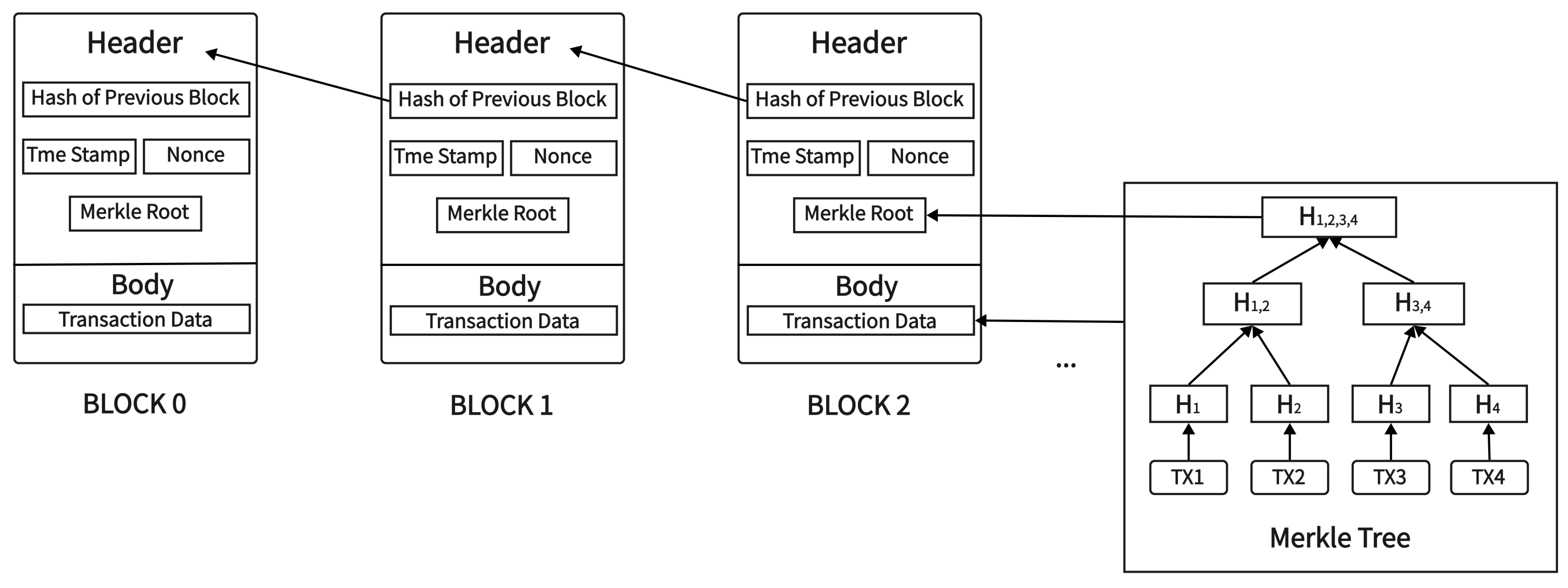
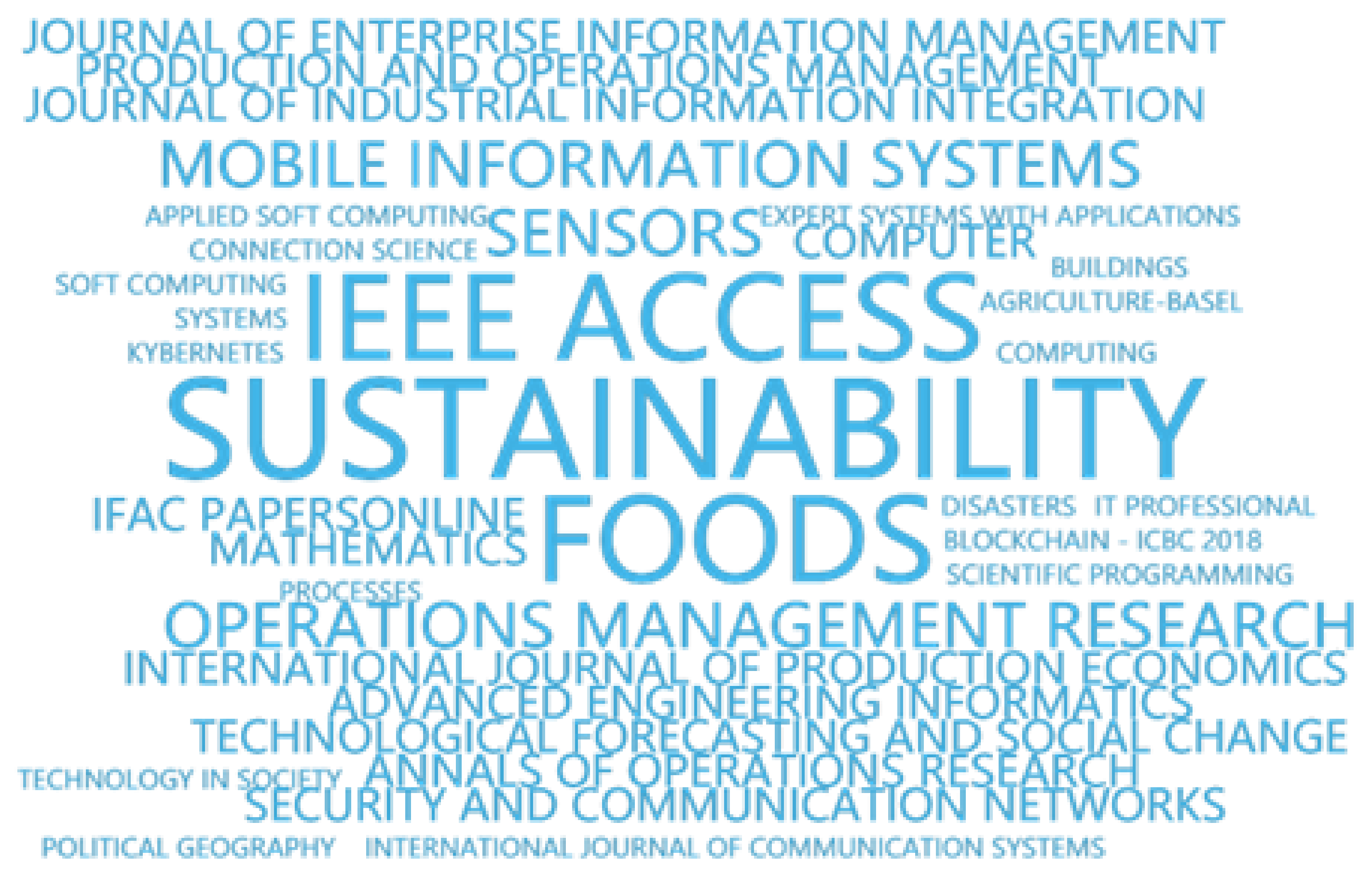
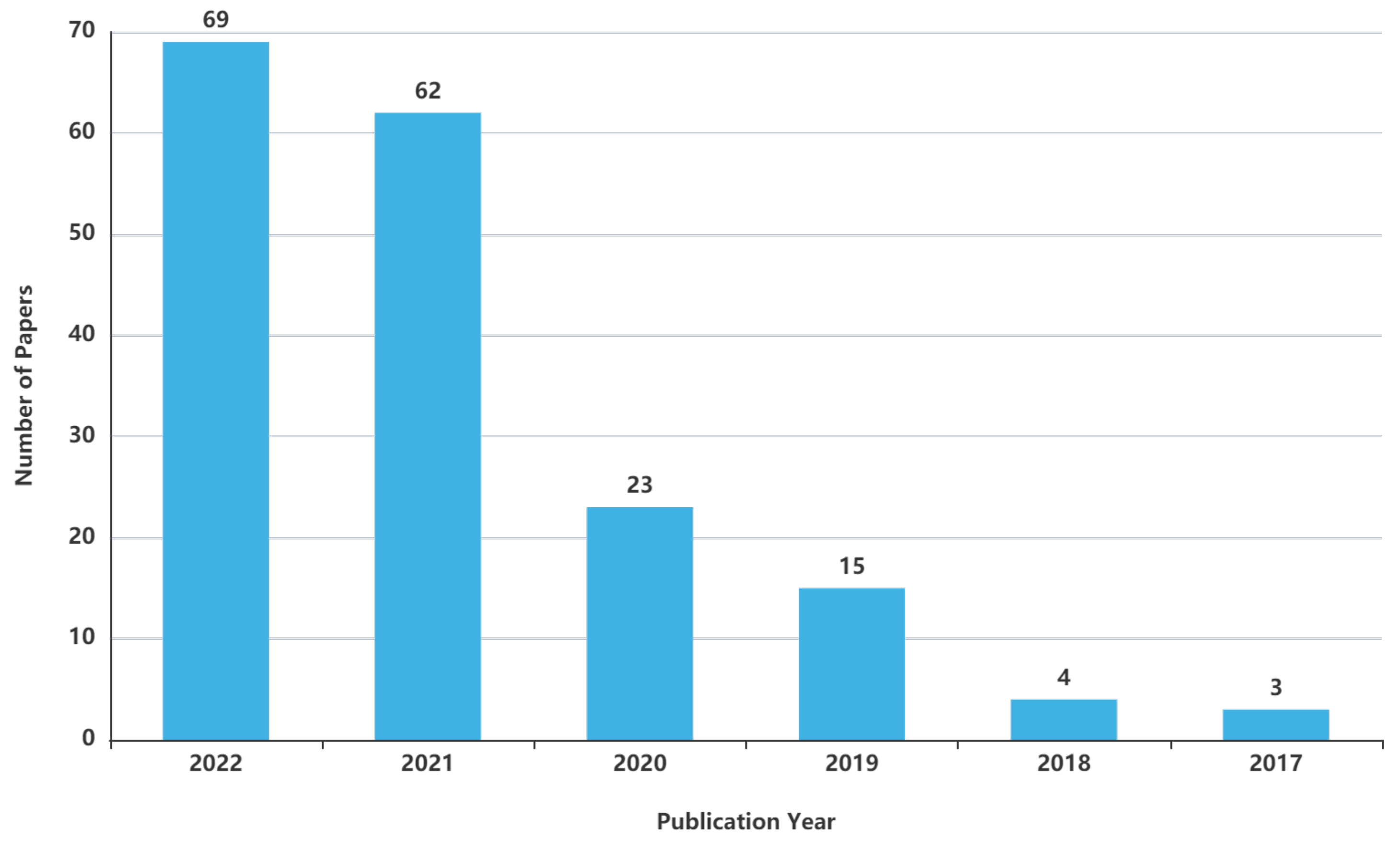
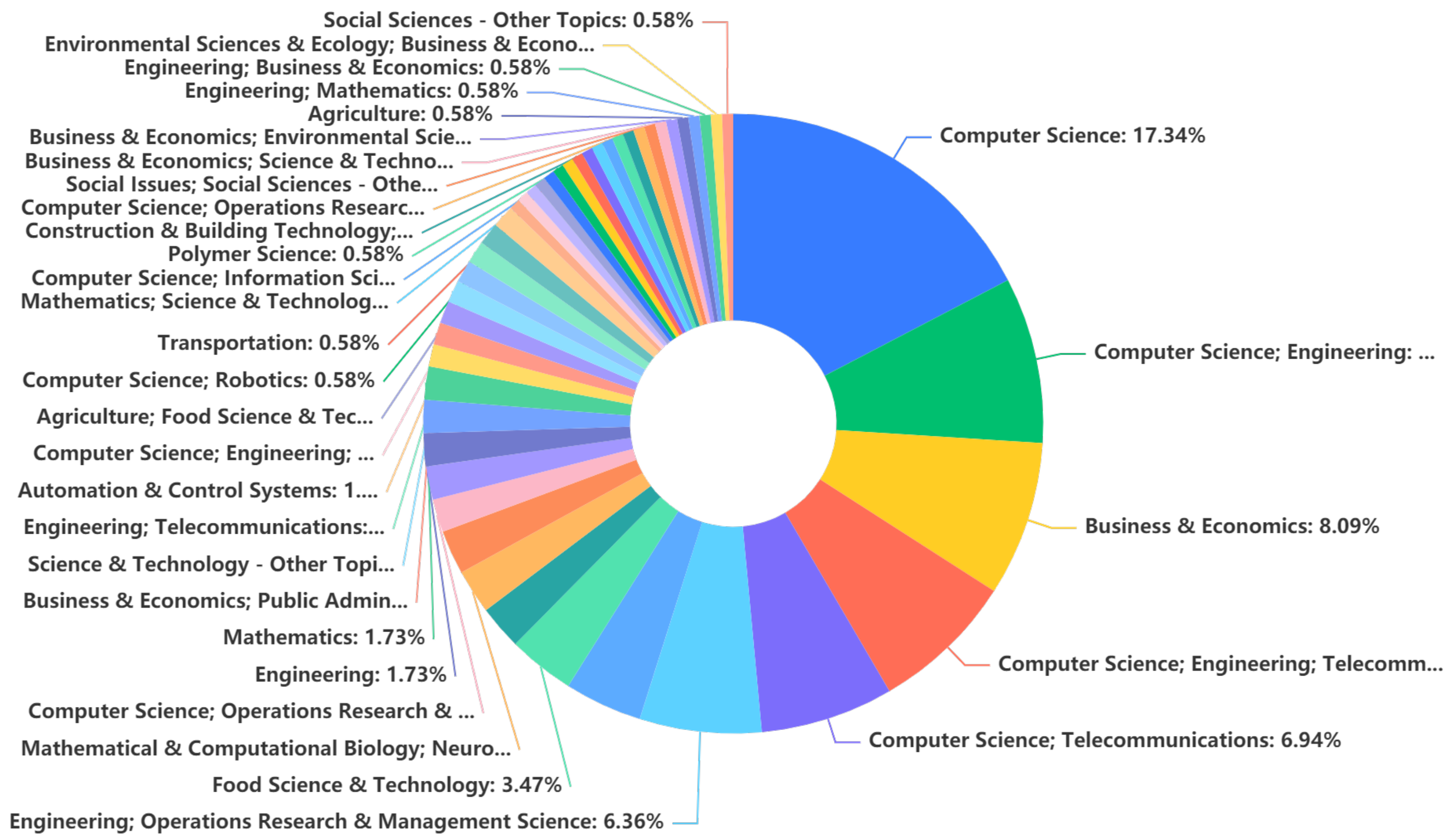
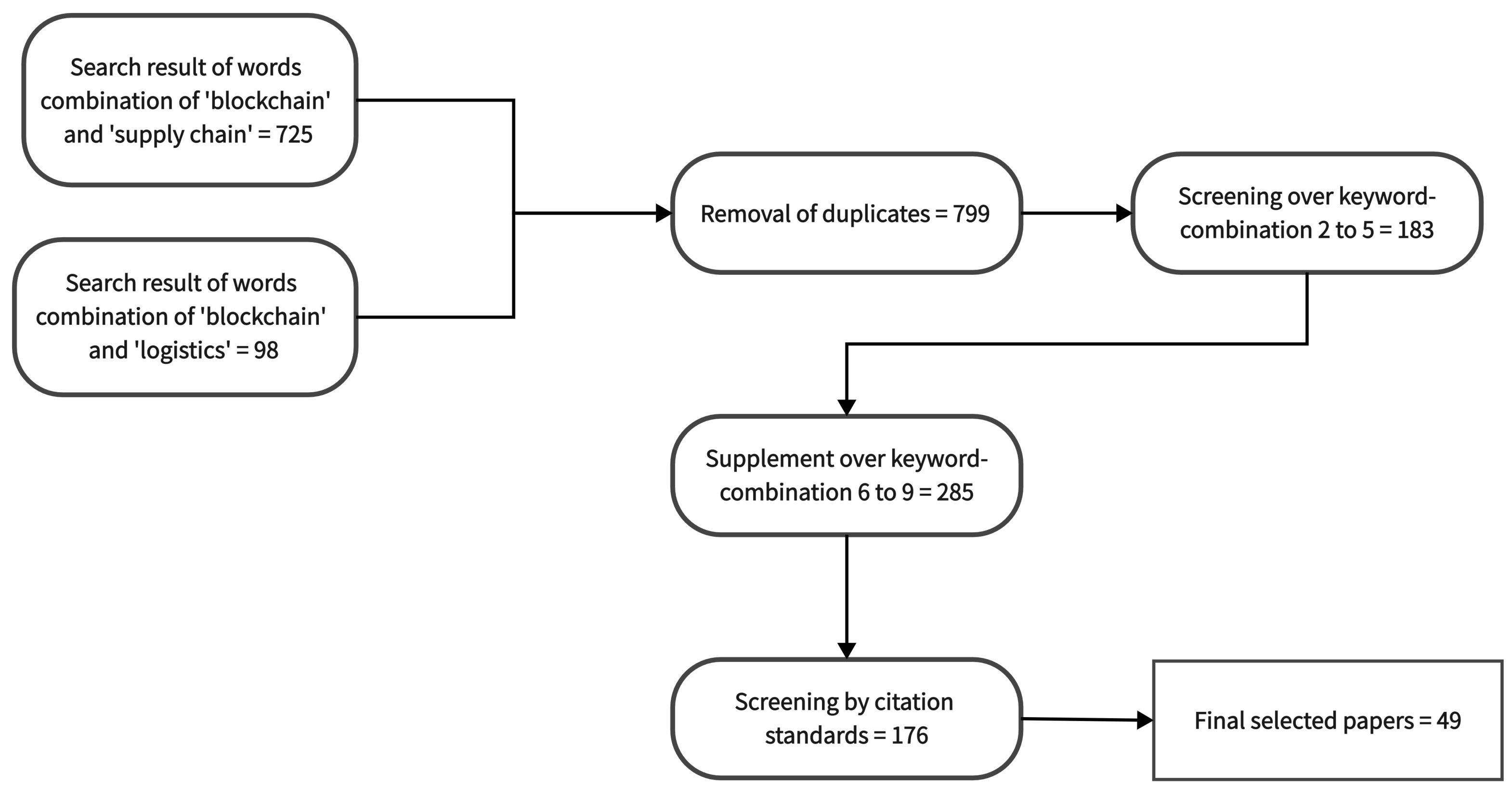
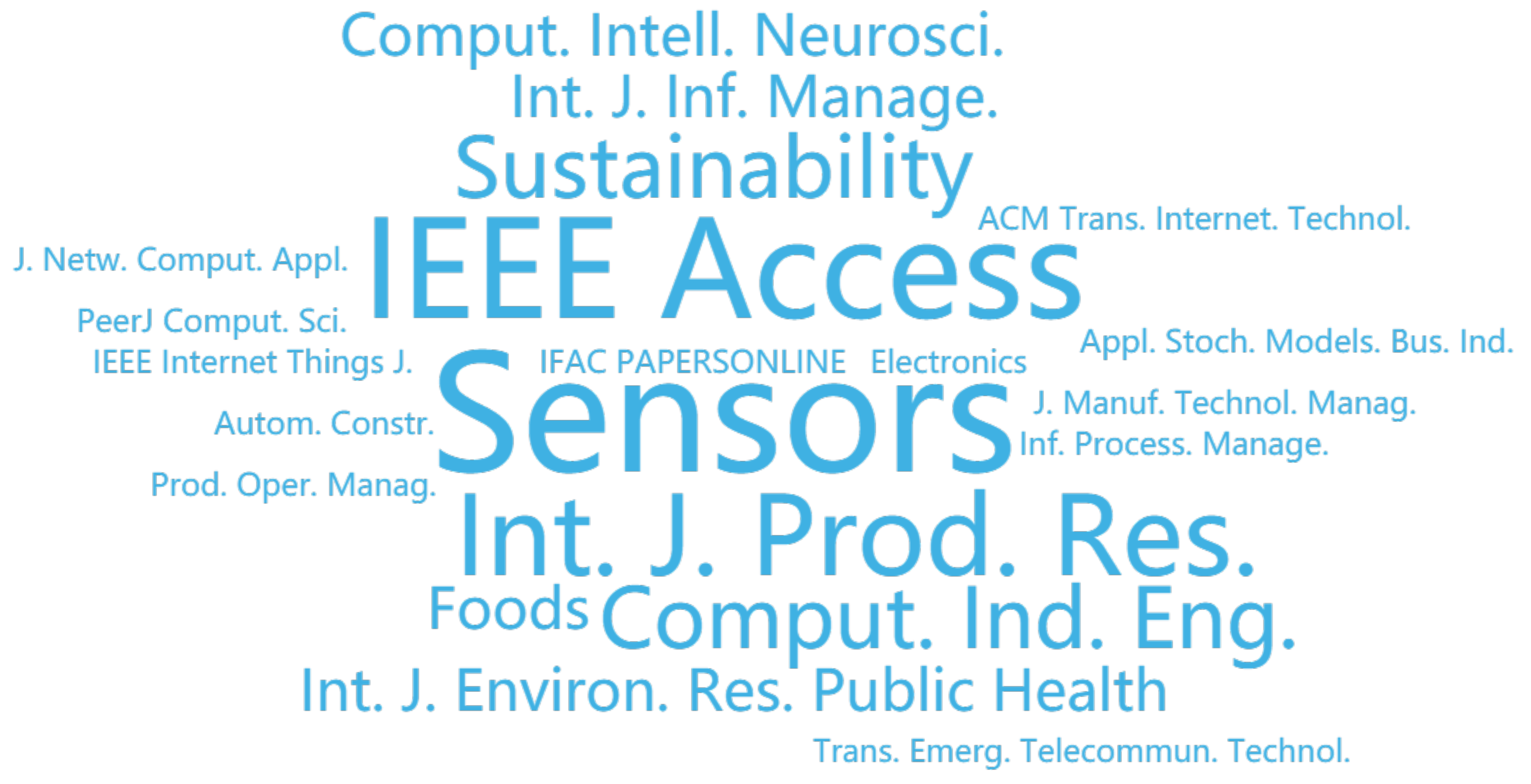
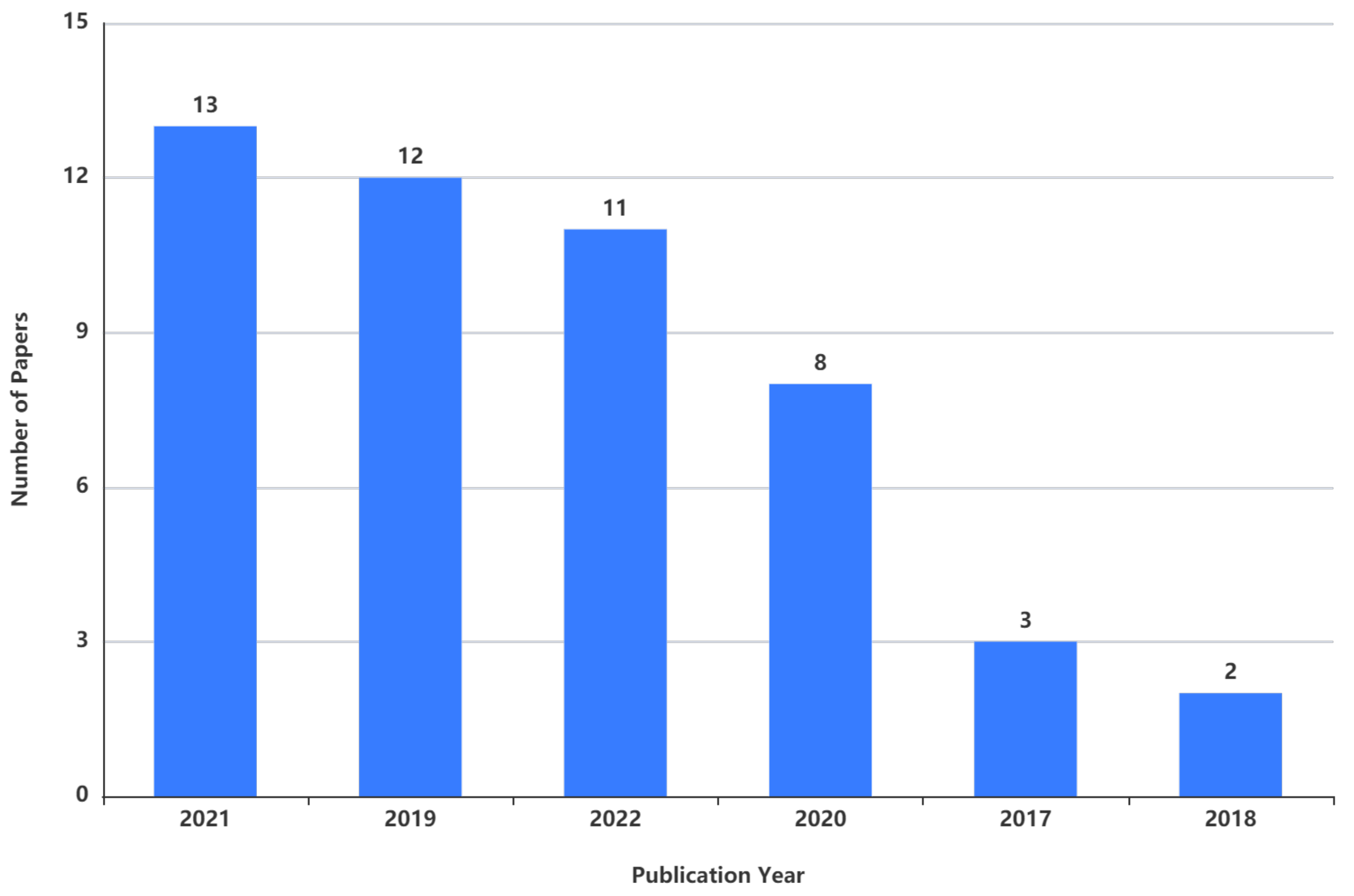
Publisher’s Note: MDPI stays neutral with regard to jurisdictional claims in published maps and institutional affiliations. |
© 2022 by the authors. Licensee MDPI, Basel, Switzerland. This article is an open access article distributed under the terms and conditions of the Creative Commons Attribution (CC BY) license (https://creativecommons.org/licenses/by/4.0/).
Share and Cite
Liu, B.; Si, X.; Kang, H. A Literature Review of Blockchain-Based Applications in Supply Chain. Sustainability 2022, 14, 15210. https://doi.org/10.3390/su142215210
Liu B, Si X, Kang H. A Literature Review of Blockchain-Based Applications in Supply Chain. Sustainability. 2022; 14(22):15210. https://doi.org/10.3390/su142215210
Chicago/Turabian StyleLiu, Boyu, Xiameng Si, and Haiyan Kang. 2022. "A Literature Review of Blockchain-Based Applications in Supply Chain" Sustainability 14, no. 22: 15210. https://doi.org/10.3390/su142215210
APA StyleLiu, B., Si, X., & Kang, H. (2022). A Literature Review of Blockchain-Based Applications in Supply Chain. Sustainability, 14(22), 15210. https://doi.org/10.3390/su142215210





